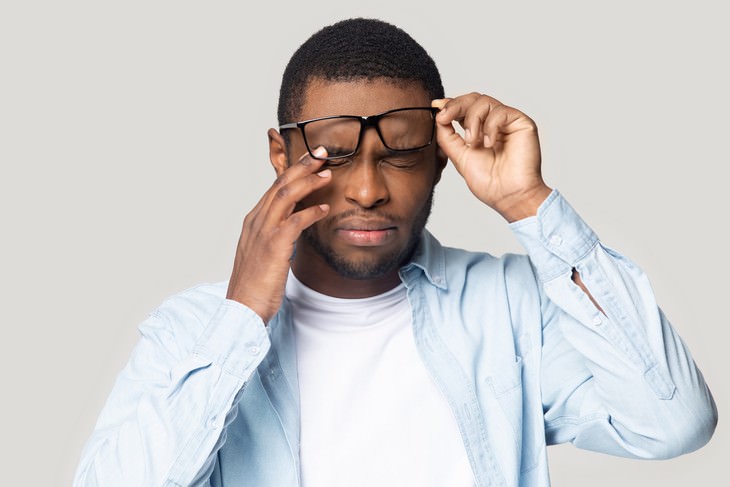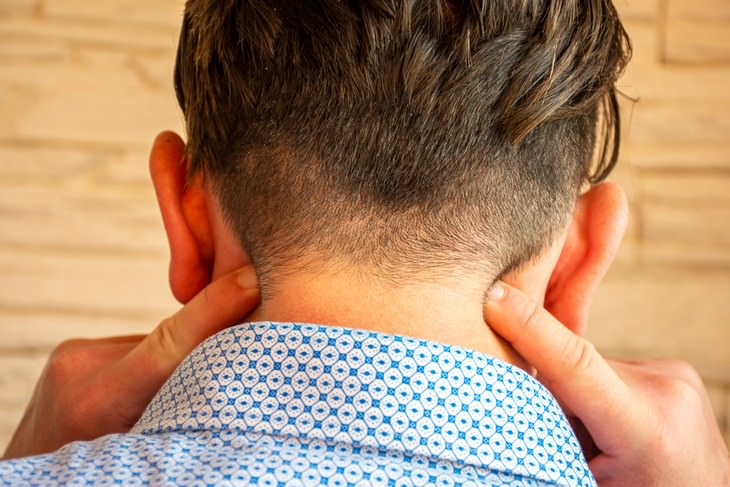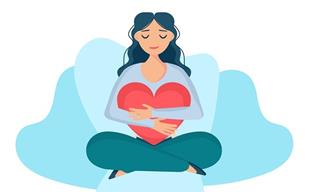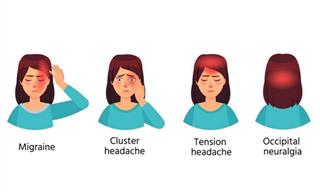The types of headaches listed in this article are primary headaches, meaning they are conditions in themselves and not a symptom of a separate underlying condition. Primary headaches can develop as a result of brain chemicals, nerves, muscle tension, and even genetics; doctors can't always pinpoint one exact cause. We rounded up their characteristics, where they stem from, and what can be done for prevention and treatment.
1. Tension Headache

Tension headaches are the most common type of primary headaches and according to the World Health Organization, they affect about half of the women population and one-third of men. They are often referred to as 'hatband headaches' because the muscles around the scalp become tight and cause pain in the back of the head, the temples and forehead as if a tight hat was in place. They tend to be pressure-like at onset and can last from hours to days.
Common triggers for tension headaches include:
- Stress
- Eyestrain
- Depression
- Fatigue
- Alcohol use or caffeine use.
Treatments and Prevention: Tension headaches are usually treated with over-the-counter pain medication like aspirin, ibuprofen, or acetaminophen (Tylenol). Chronic tension headaches are labeled as such when they occur 15 days or more in a month. In these cases, patients are sometimes treated with muscle relaxers.
An effective way to prevent tension headaches is by managing stress and learning relaxation techniques like deep breathing, yoga, or guided imagery. Try to pace yourself in your daily life, take breaks, and carve time to do the things you enjoy. For some people mindfulness - staying in the here and now, instead of following thoughts of worry and fear - proved to be helpful. A 2019 study looking at 55 women who suffer from chronic tension headaches found that those taught relaxation techniques as well as being treated with muscle relaxers experienced fewer headaches than those who only took the medication.
2. Migraine Headache

Migraine headaches involve a moderate to severe throbbing pain, usually on one side of the head. This, too, is a very common type of primary headache, about 12% of Americans experience migraines, and women are three times more likely than men to have these headaches. Other symptoms of migraines can be nausea, vision changes, and weakness. Genetics seems to play a role, as migraines often run in certain families, but scientists are still trying to figure out the exact way they might be transmitted. Because migraines are recurring, it’s important to identify their triggers, which might vary in different people. Common triggers include:
- Certain foods - for some people chocolate, yeast, and processed meat can trigger migraines, although scientists are not sure why.
- Hormonal changes - 7% to 19% of women suffer from menstrual migraines, which occur 2 to 3 days before the start of the period.
- Lack of sleep and stress - scientists have identified that stress and lack of sleep might cause hormonal changes that can trigger migraines.
If you’re not sure what is triggering your migraines, keep a migraine journal, noting everything that happened on the days leading up to the migraine. With time, a pattern is likely to be recognized.
Prevention and treatment: occasional migraines can be treated with over-the-counter medication, like aspirin, Tylenol, and other NSAIDs. However, be cautious, as overusing these medications trigger migraines, too. It’s best to consult your doctor regarding the safe use of such medication, but generally speaking, taking them once a week is safe. There are also prescription drugs that can help prevent migraines as soon as symptoms appear. Consult your healthcare provider for a migraine treatment plan that is right for you.
3. Cluster Headache

This less common type of headache is characterized by severe pain in one side of the head, particularly centered behind the eye. Other symptoms may include tearing, drooping eyelids, and nasal congestion. Cluster headaches get their name because they appear in clusters, lasting weeks to months, and they are more common in men than women. Attacks will usually occur every day, sometimes several times a day and often at the same time of the day.
Unlike the previous types of headaches we discussed, cluster headaches aren’t really associated with triggers like food or hormonal changes, or stress. In fact, the cause of these headaches is unknown but patterns suggest that abnormalities in the body's biological clock (and the hypothalamus, in particular) play a role. Moreover, once a cluster period begins, drinking alcohol may quickly trigger a splitting headache.
If you think you are experiencing a cluster headache, the best thing to do would be to see a doctor and rule out any more severe conditions. "The most serious aspect of cluster headaches is making sure that the diagnosis is correct and another secondary cause of headaches is not missed," explained physician Lean Poston.
Related: Surprising Reasons Your Head is Pounding
4. Occipital Neuralgia
This type of headache is considered quite rare. Occipital neuralgia is a condition in which the nerves that run from the top of the spinal cord up through the scalp, called the occipital nerves, are inflamed or injured. As a result, you may feel a sharp, jabbing, and electric pain in the back of your head or base of your skull. It will typically work its way up to the scalp.
Occipital neuralgia is often confused with a migraine as the two conditions have some overlapping symptoms like sensitivity to light. That’s why it’s vital to see a doctor and get the right diagnosis.
Treatment and prevention: The first steps you can take to relieve the pain are applying heat to your neck, resting in a quiet room, and massaging tight and painful neck muscles. Over the counter, anti-inflammatory drugs like naproxen or ibuprofen are also effective, and if those don’t help, your doctor may prescribe prescription medication.
If you found this article useful, pass it on and share it with others
 Go to BabaMail
Go to BabaMail




























